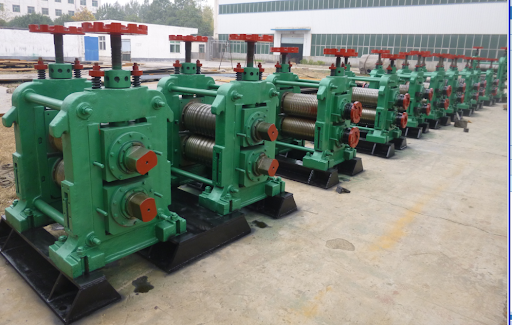What is a Rolling Mill Used for
Author : Hongteng Time: 2024-08-15
The rolling mill is the production link that rolls steel ingots or billets into steel. The production of steel by rolling has the advantages of high productivity, a wide variety of products, strong continuity of the production process, and easy mechanization and automation.

Therefore, it is more widely used than forging, extrusion, drawing and other processes. At present, about 90% of steel is rolled into products. Non-ferrous metal products are also mainly produced by rolling.
The finished products of steel rolling are mainly divided into three categories according to the cross-sectional shape of the steel: steel plates, steel pipes and steel sections (including wire rods). Steel sections have the most cross-sectional shapes and varieties. According to their uses, they can be divided into commonly used steel sections (square steel, round steel, flat steel, angle steel, channel steel, I-beam, etc.) and special steel sections (rails, steel piles, bulb flat steel, window frame steel, etc.). According to the cross-sectional shape of the product, it can be divided into simple cross-sectional steel sections and special cross-sectional steel sections. The characteristic of a simple cross-sectional section is that the tangent line made at any point on the periphery of its cross-sectional section generally does not intersect the cross-sectional section. According to the production method, it can be divided into rolled steel, bent steel and welded steel. Plate and strip materials have the widest application range. Plate and strip steel can be divided into hot-rolled plate and cold-rolled plate according to the manufacturing method. According to the use, it can be divided into boiler plate, bridge plate, shipbuilding plate, automobile plate, electrical steel plate, etc. It is usually classified by product thickness: 1) Medium and thick plate: 4~60mm thick, up to 25m long, generally supplied in blocks; 2) Thin plate: 0.2~4mm thick, up to 2800mm wide, can be cut into fixed lengths, or supplied in rolls. 3) Foil: 0.2~0.001mm thick or thinner, 20~600mm wide, generally supplied in rolls. Steel pipes are also widely used. The specifications of steel pipes are expressed by external dimensions (seamless pipes are nominally outer diameters, water-gas pipes are nominally inner diameters) and wall thickness. Its cross section is generally a round pipe, and there are also a variety of special-shaped steel pipes and variable-section steel pipes. According to the manufacturing method, it can be divided into seamless steel pipe, straight seam welded pipe, spiral welded pipe, cold rolled steel pipe, etc. According to the use, it can be divided into steel pipe for pipeline, oil pipe, boiler pipe, geological drilling pipe, bearing steel pipe and injection needle pipe, etc. Steel pipe with outer diameter of 0.1mm~2m and wall thickness of 0.01~100mm is more commonly used.
